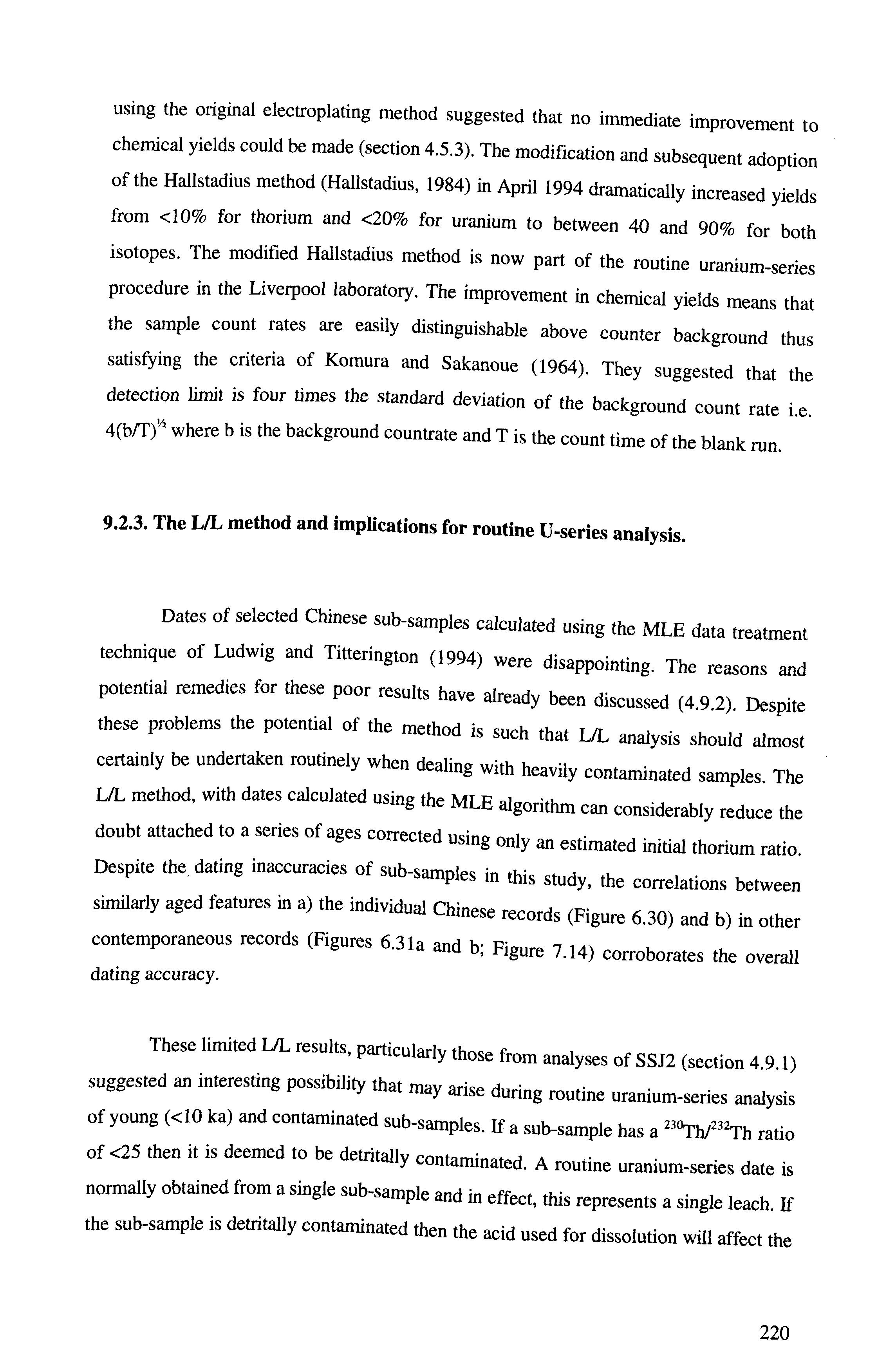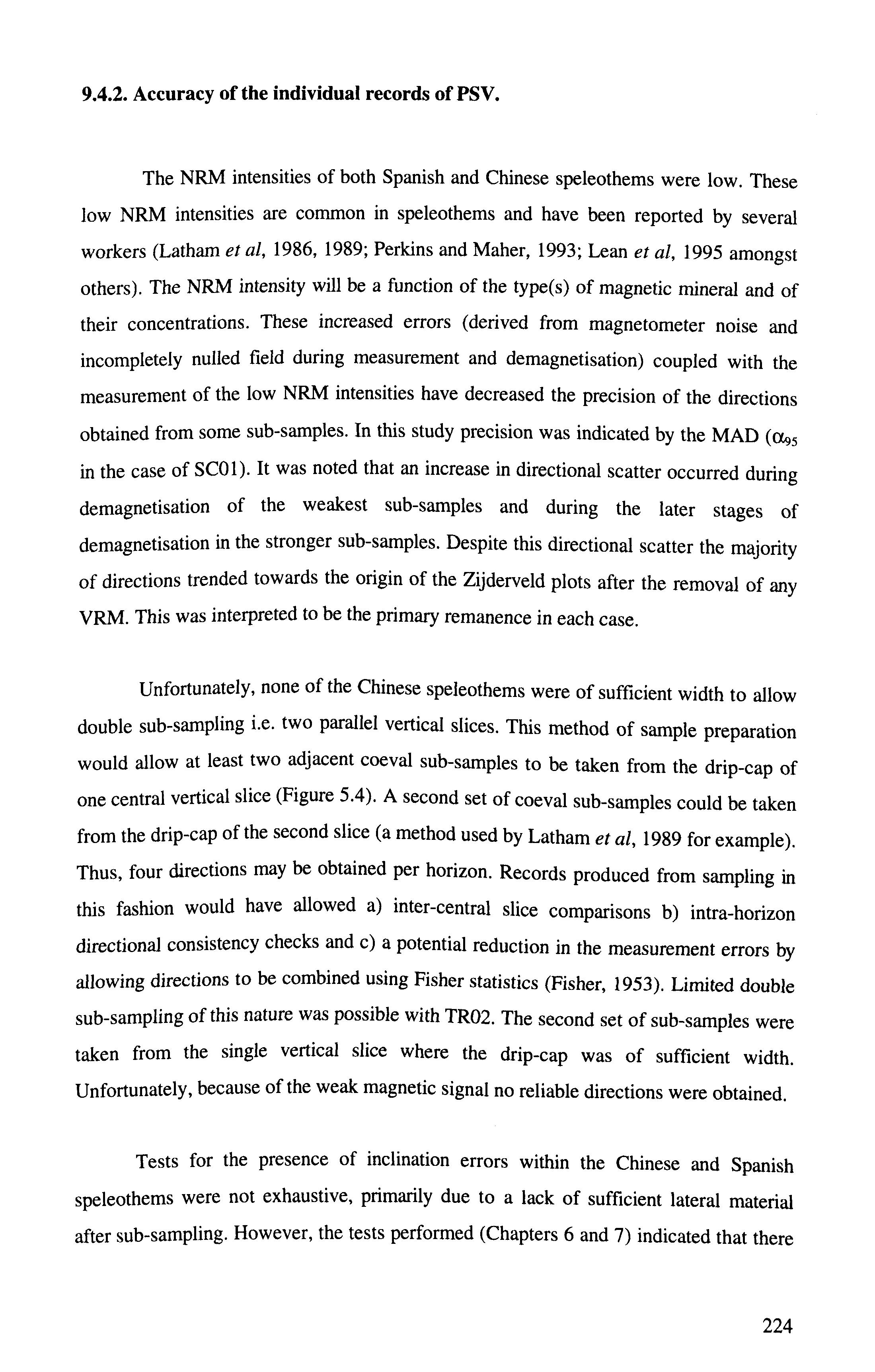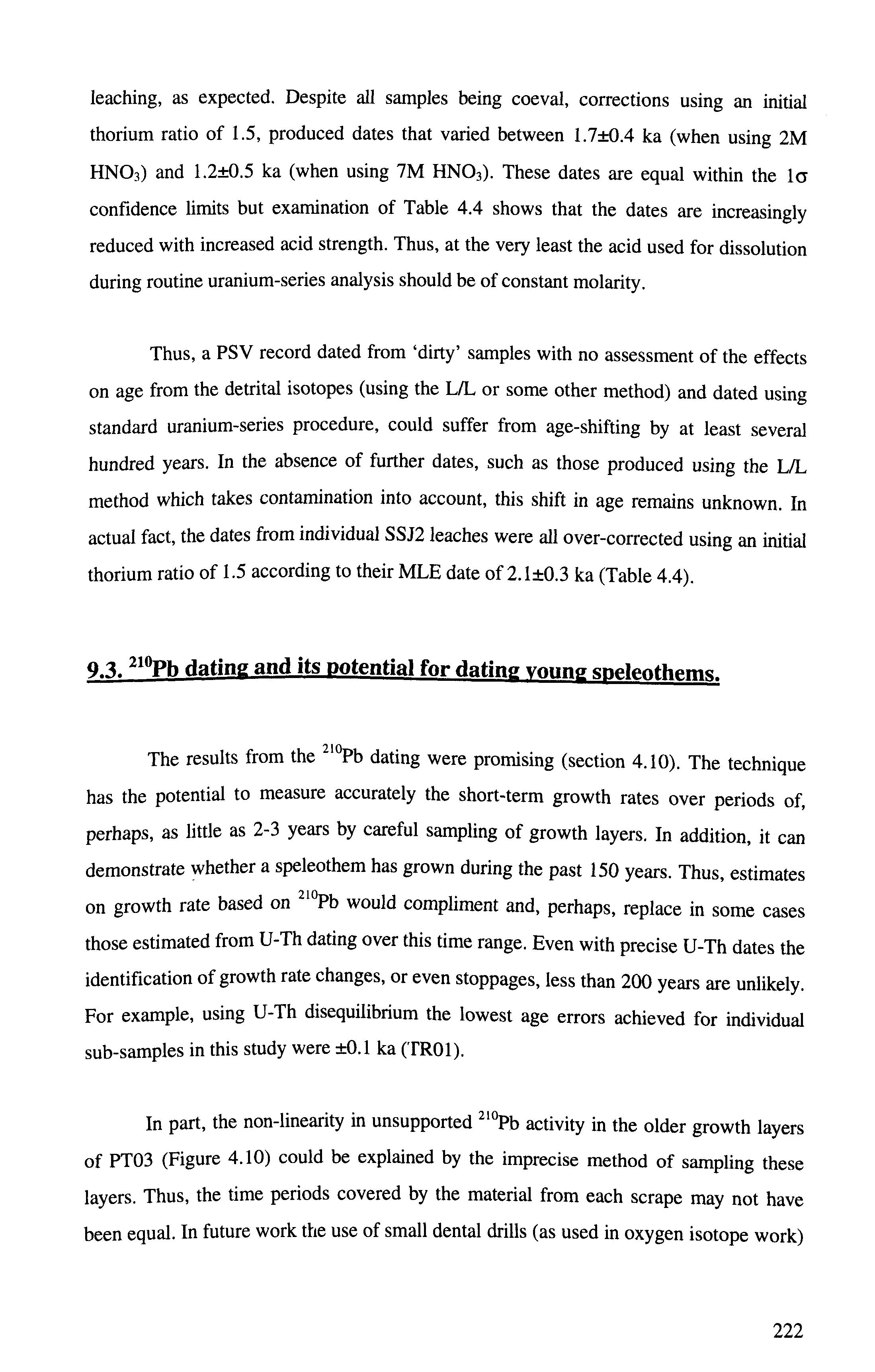
7 minute read
Appendix J
Appendix J. Uranium Series Dating Procedure
Note that this memo applies to the dissolution and isotope separation of calcite speleothems. Other materials may require subtle changes in procedure.
Advertisement
A) Sample Preparation
1. Weigh sample and note down sample number and details on dating sheet. 2. Place sample in labelled 250 ml beaker and add just enough 7M H N 03 to cover sample. More acid can be added if the solution saturates before complete dissolution.
3. Filter solution using Whatman 54 acid hardened filter paper. Rinse filter paper with acid once drained through. 4. Carefully add 0.5ml 232U/228Th spike solution and up to lml FeCl3 (depending on Fe content o f dissolved sample). 5. Boil sample down to approximately 100ml, and add l-2ml HCL04. Reduce heat, cover and reflux for 30 minutes. 6. Add a few mis of 7M H N 03 and increase volume to just under 200 mis with distilled water.
7. Heat whilst stirring and boil for 10 minutes (to drive o ffC 0 2). 8. Turn off heat, cool until sign of boiling cease. Increase stirring speed and add just enough NH3 to produce a dark brown precipitate which remains. 9. Cover and leave for several hours allowing precipitate to flocculate and sink to base o f beaker.
10. Transfer to centrifuge tubes flushing all precipitate from the beaker with distilled water. From a squeezy bottle rinse sides of beaker with 9N HC1 and add 0.5 ml FeCl3 to the acid rinse which is left in the beaker. Once centrifuged pour clear supernate from the centrifuge tubes back into this beaker. Leave first precipitate in centrifuge tube to dry. 11. Repeat steps 7 - 10 for the second scavenge of U and Th. This time the supernate and washings are discarded. 12. Transfer precipitate to one centrifuge tube and leave to dry for several days until surface of precipitate begins to crack.
The above procedure takes approximately 2 days plus precipitate drying time. Thus, it is useful to keep a set of samples prepared in advance for the following stage which can be achieved the day before the previous samples come off the alpha-spectrometer.
B) Removal of Iron and Further Destruction of Organics
13. Dissolve dried precipitate in centrifuge tube with 5ml cone. HC1. 14. Pour into separating funnel and rinse centrifuge tube with 9N HC1. 15. Add an approximately equal measure of Iso-Propyl Ether (IPE) and shake funnel vigorously several times. Hold funnel upside down and open valve to allow degassing between shakes. 16. Remove bung and leave for 5 mins, or until the liquid interface is clearly defined. 17. Drain lower layer into a new beaker (pre-rinsed with 9N HC1). 18. Repeat steps 14 - 17 if yellow coloration remains (until aqueous layer becomes clear). 19. Heat beaker very gently on hot plate. Solution becomes cloudy and ether fumes are seen to rise up the beaker sides. 20. When solution becomes clear and ether fumes have disappeared, remove from heat and add a few drops o f cone. HC1. 21. If after repeating steps 14- 20 the yellow colour remains there is another organic chelating the Fe (+ U and Th). In order to break down the organic the solution must be boiled down and refluxed with more HCL04.
This procedure can be performed the day before you intend to count the sample on the alpha spectrometer. However, if further destruction of organics is required extra delays will be incurred. NOTE: From experience a slight yellow coloration after IPE
treatment appears to have little effect on yield or the cleanliness of the spectra.

Q Separation of U from Th
22. Set up first ion exchange column with approx. 5 cm depth of anion exchange resin and rinse several times with 0 .1M HC1 to remove any organics from the resin. 23. Precondition the resin with 2 x 20ml washes of 9N HC1. 24. Add sample (which should have cooled from step 20) 25. Start collecting for Th in 250ml beaker pre-rinsed with 9N HC1!!! 26. Set drip rate at 1 drip every 2 seconds. 27. When solution drained through add 20ml 9N HC1. Remaining Th should be eluted. 28. Change beakers and add 50ml 0 .1M HC1 to elute U.
Wh,le waiting for Th to drip through (can be 2 Hours) now is a good time to set up the next columns (U and Th). Once past this stage both the U and Th should be put through the subsequent columns simultaneously. This saves a great deal o f time although a careful record should be kept in a note book as to what stage each column is at. The next sechons are in the correct chronological sequence. So far the first column will have taken about 2 - 3 hours.

D) Thorium Preparation
29. Set up third ion exchange column with approx. 5cm depth of cation exchange resin. This should be rinsed thoroughly with 0 .1M HC1. 30. Precondition with 2 x 20ml 2M HC1.
31. Dilute the Th elute from step 27 with 2 volumes o f distilled water. This alters the molarity from 9M to 3M. Do not dilute more than necessary; Th sticks to glassware <pH 3. 32. Add sample to column. Set drip rate to 1 drip every 2 seconds 33. When solution drained through wash with 20ml 2M HC1. 34. Elute Th using 50ml 6M H2S 0 4 into a 50m 1 Pyrex beaker.
E) Uranium Preparation
35. Gently evaporate the U elute from step 28 to almost dryness. 36. Dissolve the residue in 5ml cone. HN03 and 5ml 7M H N 03, 37. Set up second ion exchange column with approx. 5 cm depth of anion exchange resin. This should be thoroughly rinsed with 0 .1M HC1. 38. Add sample to column setting drip rate as before. 39. When solution drained through wash with 20ml 7M H N 03 (removes remaining Fe). 40. When solution drained through wash with 10ml 9M HC1 (removes remaining Th). 41. Discard elutant.
42. Elute U with 50ml 0.1 HC1 into a 50ml Pyrex beaker.
Procedures D and E will take approximately 3 hours to complete. Ideally Th should be plated and counted first since it has a habit of sticking to glassware and vanishing into thin air for no apparent reason!! Thus it is suggested that the following electroplating section is performed with Th elute first.

F) Electroplating
There are a number of electroplating methods in common use today and some knowledge of them is desirable. It has been found that the difference in yields between the various methods can be large. A great deal of experimentation is needed to find a method that is satisfactory in terms of yield, plating time, and ease of preparing the elute for electroplating.
Initial electroplating was performed using the following technique. 1. Slowly evaporate the U elute to approximately 5 ml ensuring that the beaker does not dry out. Make up volume with H20. 2. Add a drop of HN03 to Th elute to oxidise any remaining organics. 3. Add a few drops of thymol blue indicator solution to both U and Th solutions. 4. Add NaOH slowly and adjust pH to 3.0 (straw colour). 5. Transfer solutions to the large electroplating cells and make up the volume with electroplating solution. 6. Electroplate at 0.4A for 4 hours topping up electrolyte as required. 7. Turn off current, empty solution into original beakers, wash and label planchéis. 8. Count on alpha-spectrometers.
This technique does not provide good chemical yields for calcite speleothems
After experimentation we found that the electroplating method proposed by Laars Hallstadius to give 40-50% greater yields although variable Reference is Hallstadius, L. (1984). A method for the electrodeposition of actinides N ucl I m * Meth., 223, 266-267.

1. Evaporate the sample to a few mis in a 100ml beaker (Thorium is in sulphuric acid so heating should be very gentle). 2. Remove from heat and cool on gauze 3. Add 1ml 0.3M Na2S 0 4 (acts as a carrier). 4. Evaporate to total dryness (Takes up to 2 hours for Th). 5. Cool and add exactly 0.3ml cone. H SO 6. Warm and swirl to dissolve residue. Avoid evaporating H ,S04 more than necessary. 7. Add 4ml distilled water and 2 drops 0.2% thymol blue. 8. Dropwise add NH3 to a yellow - yellow orange colour.
9. Pour solution into electrodeposition cell and rinse 50ml beaker with 5ml 0.1% H2S 0 4. 10. Pour into cell and adjust pH. to 2.1 - 2.4 with NH3, or, if the end-point is overstepped, 20% H2S 0 4. 11. Electrolyse for 0.6A for 2 Hours (the original technique suggests 1.2A for 1 hour but our equipment will not tolerate this current for so long). 12. Add 1ml NH3 lmin before switching off current. 13. This step should be accomplished in one smooth and quick operation! Have the required equipment and chemicals ready!! Turn off current, empty cell into original 50ml beaker, rinse planchet (still in cell) with distilled water. Panic over. Now dismantle cell, rinse again with water and acetone,dry and label. 14. Count.









